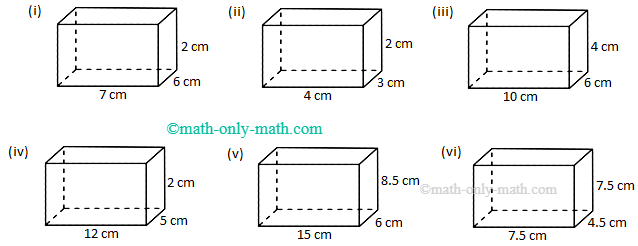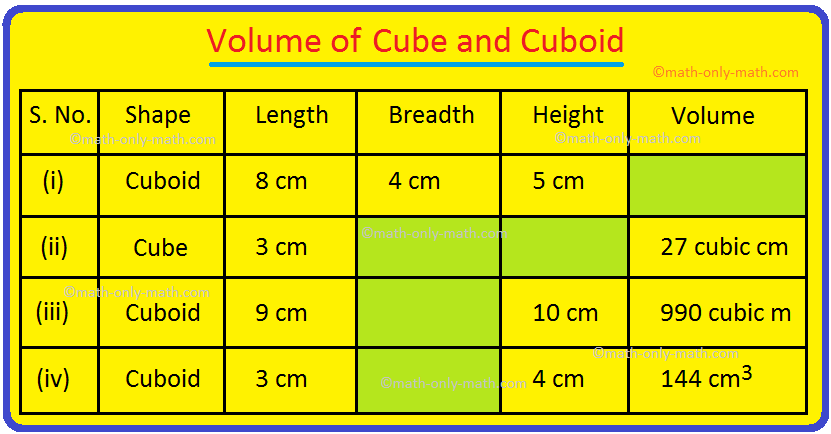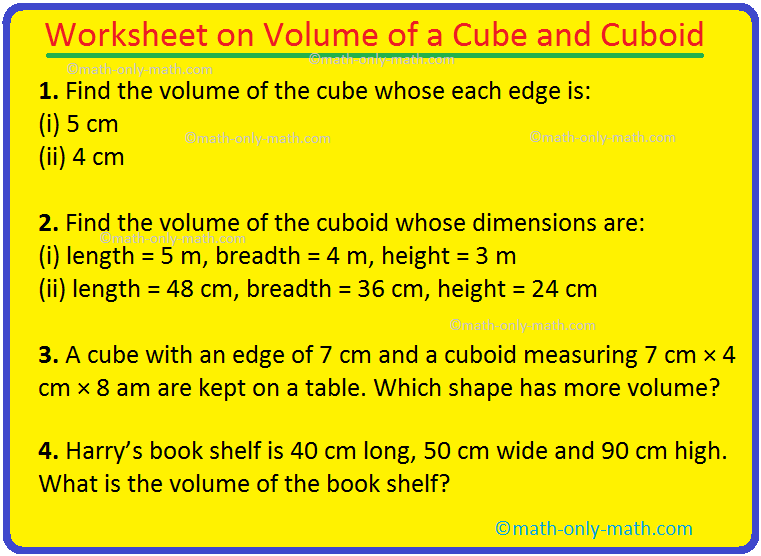Subscribe to our ▶️ YouTube channel 🔴 for the latest videos, updates, and tips.
Worksheet on Volume of a Cube and Cuboid
We will practice the questions given in the worksheet on volume of a cube and cuboid. We know the volume of an object is the amount of space occupied by the object.
1. Fill in the blanks:
(i) The volume of a rectangle box (or cuboid) = ________ × ________ × ________
(ii) The volume of a cube = ________ × ________ × ________
(iii) The volume of a 1 cm cube is ________
2. Find the volume of the cube whose each edge is:
(i) 5 cm
(ii) 4 cm
(iii) 6 cm
3. Find the volume of the cuboid whose dimensions are:
(i) length = 5 m, breadth = 4 m, height = 3 m
(ii) length = 48 cm, breadth = 36 cm, height = 24 cm
(iii) length = 12 m, breadth = 5 m, height = 4 m
Worksheet on Word Problems on Volume of a Cube and Cuboid:
4. A cube with an edge of 7 cm and a cuboid measuring 7 cm × 4 cm × 8 am are kept on a table. Which shape has more volume?
5. A cuboid is 9 cm long, 5 cm broad and 4 cm high and a cube has an edge of 5 cm. Which one has greater volume?
6. What is the volume of a brick of ice-cream with length 25 cm, breadth 10 cm and height 8 cm?
7. A brick measures 15 cm in length, 8 cm in breadth and 5 cm in height. How many bricks will be used to make a wall of length 15 m, breadth 10 m and height 8 metres?
8. A pond is 50 m long, 30 m wide and 2 m deep. Find the capacity of the pond in cubic metre.
9. Harry’s book shelf is 40 cm long, 50 cm wide and 90 cm high. What is the volume of the book shelf?
10. The volume of a cuboid, having its length 22 m and height 8 m, is 2640. Find its breadth.
11. A room is 7 m long, 4 m broad and 3 m high. Find the volume of air the room.
12. A water tank contains 640 m³ of water. Its breadth is 8 m and length is 16. What is the height of the tank?
13. How many rectangular pieces of wood of size 8 cm x 6 cm x 2 cm can be cut from a log of wood of size 8m x 3m x 1m?
14. An aquarium is 2 m long, 80 cm wide and 50 cm high. How many cubic centimetre of water will it hold?
15. Find the volume of the following rectangular solids:
16. Complete the given table:
Answers for the worksheet on volume of a cube and cuboid are given below.
Answers:
1. (i) length × breadth × height
(ii) Side × Side × Side
(iii) 1 cu cm
2. (i) 125 cu cm
(ii) 64 cu cm
(iii) 216 cu cm
3. (i) 60 cu m
(ii) 41472 cu cm
(iii) 240 cu m
4. Cube
5. cuboid
6. 2000 cu. cm
7. 20000
8. 3000 cu m
9. 180000 cu. cm
10. 15
11. 84 m3
12. 5 m
13. 250000
14. 800000 cu. cm
15. (i) 84 cu cm
(ii) 24 cu cm
(iii) 240 cu cm
(iv) 1200 cu cm
(v) 765 cm3
(vi) 253.125 cm3
16. (i) 160 cu cm
(ii) 3 cm, 3 cm
(iii) 11 cm
(iv) 12 cm
● Volume.
Worksheet on Volume of a Cube and Cuboid.
5th Grade Geometry Page
5th Grade Math Problems
5th Grade Math Worksheets
From Worksheet on Volume of a Cube and Cuboid to HOME PAGE
Didn't find what you were looking for? Or want to know more information about Math Only Math. Use this Google Search to find what you need.





New! Comments
Have your say about what you just read! Leave me a comment in the box below. Ask a Question or Answer a Question.